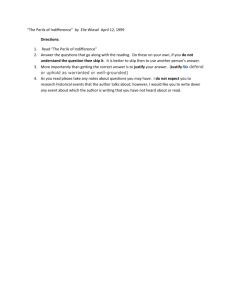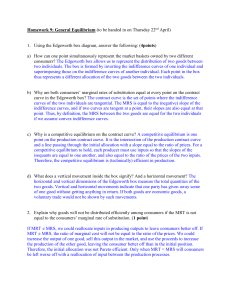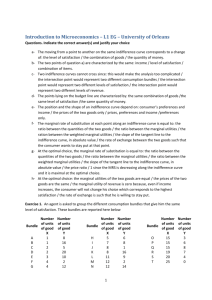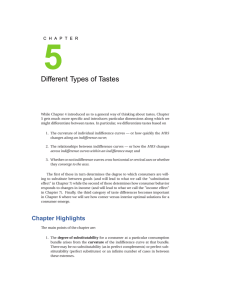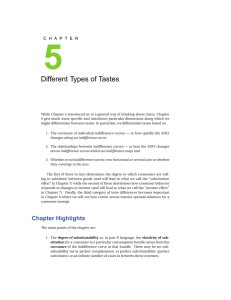Economics 001 Principles of Microeconomics Professor Arik Levinson •Lecture 9
advertisement
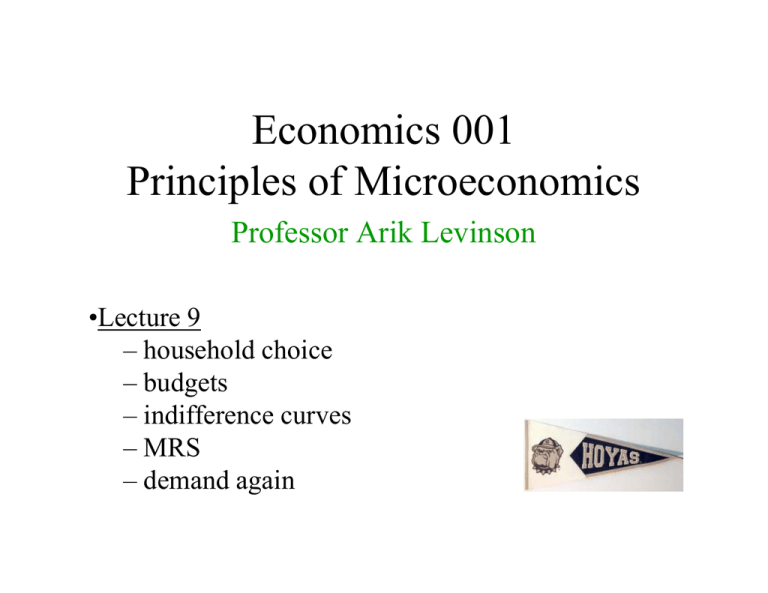
Economics 001 Principles of Microeconomics Professor Arik Levinson •Lecture 9 – household choice – budgets – indifference curves – MRS – demand again A diagram of the economy Demand Households goods and services $ Firms Supply Household budget constraint • $100 per week to spend on food and clothing – food costs $5 per meal – clothing costs $10 per article 10 unaffordable P slope P clothing food clothes affordable 20 food Consumption Possibilities PCQC + PFQF = Y Divide both sides of this equation by PC, to give: QC + (PF/PC)QF = Y/PC Then subtract (PF/PC)QF from both sides of the equation to give: QC = Y/PC – (PF/PC)QF The term Y/PC is the left intercept: real income in terms of clothes, the maximum that can be spent entirely on clothes. The term PF/PC is the relative price of a food in terms of clothes, the slope of the budget line. 3 changes: • 1) Price inflation • 2) Income increases • 3) Relative price changes 1) Price inflation 10 • Inc = $150 • Pfood=$7.50 • Pclothes=$15 Nothing changes! clothing 20 food 2) Income grows 50% 15 • Inc = $150 • Pfood=$5 • Pclothes=$10 10 clothing 20 food 30 3) Food price doubles • Inc = $100 • Pfood=$10 • Pclothes=$10 10 clothing 10 20 food Preferences • Assumption #1: More is better. • DN: Indifference curve = set of points (combinations of goods) among which a consumer is indifferent. An indifference curve 10 Clothing 8 c 6 Preferred 4 Not Preferred 2 0 2 4 g 6 8 Food 10 A set of indifference curves 10 Clothes 8 c 6 j 4 I2 2 0 g 2 4 6 I1 I0 8 Food 10 • Assumption #2: Indifference curves never cross • Assumption #3: Indifference curves not bowed outwards from origin Marginal Rate of Substitution DN: Marginal rate of substitution (MRS) = rate at which consumer willing to trade goods = slope of indifference curve = how much Y (clothes) for 1 unit X (food) Marginal Rate of Substitution 10 8 Clothes MRS = 2 6 c 4 MRS = 1/2 2 g I1 0 2 4 6 8 Food 10 Marginal Rate of Substitution • Notice: As the consumption of food increases, the MRS decreases. – This is referred to as the diminishing marginal rate of substitution. Substitutes and complements (again) • The shape of the indifference curves reveals the degree of substitutability between two goods. Marker pens at the local supermarket Degree of Substitutability 10 Perfect substitutes 8 6 4 2 0 2 4 6 8 10 Marker pens at the campus bookstore Left running shoes Degree of Substitutability 5 Perfect complements 4 3 2 1 0 1 2 3 4 5 Right running shoes Budget Preferences C C F F •Defined by: •PC, PF, income •Assumptions: •more better •no X-ing •bowed in •Slope = PF/PC •Slope = MRS Soda (six-packs per month) Put the two together . . . . 12 f •Inc=$36 •Pmovie=$6 •Psoda=$3 Best affordable point: MRS=Pmovies/Psoda c 6 d i I2 h I1 I0 0 3 6 Movies (per month) •Inc falls to $24 •Pmovie=$6 •Psoda=$3 Soda (six-packs per month) Income effects 12 Income $36 8 j 6 4 I2 Income $24 0 I1 2 3 4 6 Movies (per month) •Inc=$36 •Pmovie falls to $3 •Psoda=$3 Soda (six-packs per month) Price effects 12 Best affordable point: movies $6 c 6 j 3 Best affordable point: movies $3 I1 0 3 6 9 12 Movies (per month) I2 Good Y Good X Good Y Demand Curve Good X Px Good X
